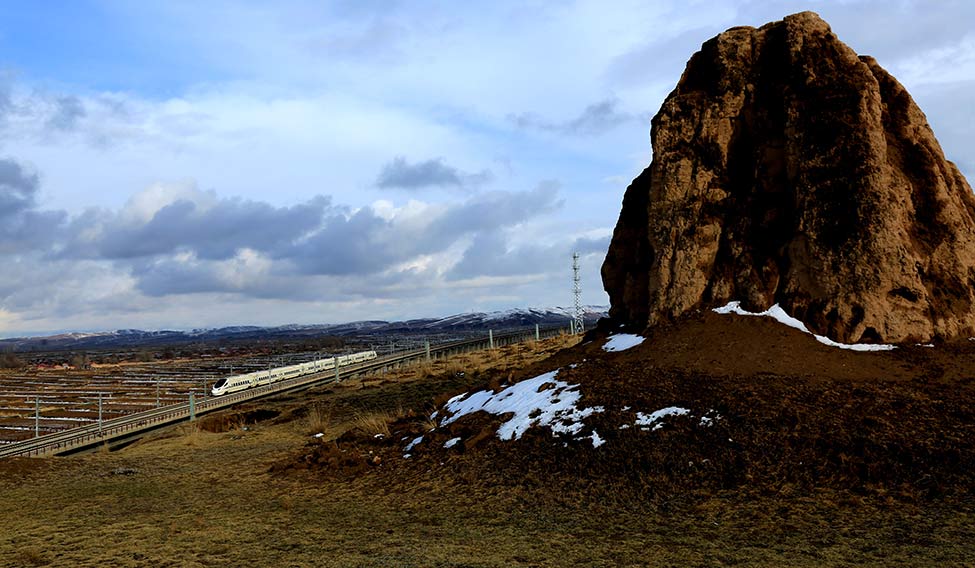A Hami melon is so much like Xinjiang. A white filigree runs over its yellow rind. So much like a map, or like the pattern on a bottle of Old Monk rum. And, under the melon’s intriguing skin lies pale yellow bliss. The melon is a gift of the desert. So is Xinjiang, the province that hides much under its skin.
A string of high-altitude oases, this province lies at the heart of China’s One Belt One Road initiative. Look out of the window before the aircraft descends into Urumqi, and see a land painted in varying shades of grey. The retiring sun smears gold on the snow-capped crags of the Tian Shan range. And, then, Urumqi. A flash of green. A blaze on the horizon.
Urumqi is more than a city on the ancient Silk Route. It is a conversation between cultures, between time. Uyghur Muslims make up close to 46 per cent of the province, but there are many more ethnicities in the mosaic. Just as Perth is the world’s most remote city, Urumqi is the city farthest from the sea. And, it is the ‘heart’ of Asia. Twenty-five kilometres from Urumqi, stands an 18m tower to mark the geographical centre of the continent. Of course, such a marker does not go uncontested. The Russians say the heart of Asia lies in Kyzyl, in the Tyva Republic.
However, Urumqi’s remoteness does not put it too far from Beijing. Everything, from architecture to infrastructure and agriculture, has a Beijing touch. For example, here, the sunset is at around 9pm, Beijing Time. Beijing goes to work at around 8am, and, to compensate, Urumqi clocks in at 10am.
To begin with, Beijing has eight reasons to keep a firm hand on Xinjiang—Russia, India, Pakistan, Afghanistan, Tajikistan, Kyrgyzstan, Kazakhstan and Mongolia. Eight countries border this one province, making it a “bridgehead in Eurasia”. The province has identified reserves of 139 types of minerals. For example, 30 per cent of China’s onshore oil reserves and 40 per cent of coal reserves lie here. Add to all these the fact that “54 countries have invested in Xinjiang”.
So, China’s core interest in Xinjiang is not simply hegemonic as made out to be. It is commercial. Beijing’s policies in the province should be seen in this perspective. The same applies to OBOR. It is an investment and China is committed to dealing with the risks appropriately.
In his keynote address at the Belt and Road Forum on May 14, President Xi Jinping dropped a broad hint: “Finance is the lifeblood of modern economy. Only when the blood circulates smoothly can one grow.” Even when Xi first broached the OBOR dream in 2013, market-watchers had speculated that it could be rooted in China’s need to create new markets and improve its return on investment. Peter Wong Tung Shun, deputy chairman and chief executive, HSBC, said recently that OBOR could also be aimed at pushing the internationalisation of the yuan.
On May 24, 2017, Moody’s Investors Service downgraded China’s credit ratings for the first time in 30 years. Moody’s said the downgrade reflected the “expectation that China’s financial strength will erode somewhat over the coming years, with economy-wide debt continuing to rise as potential growth slows.”
The Chinese finance ministry said Moody’s was exaggerating the difficulties and underestimating China’s ability to “deepen supply-side structural reform and appropriately expand aggregate demand”. That’s true to an extent, considering that state control over major sectors is significant and, perhaps, without parallel.
OBOR factors greatly in Beijing’s plan to boost demand. And, China’s strategy in Xinjiang could be seen as a model for OBOR. For example, Xi’s worry about circulation could be applied in Xinjiang. The landlocked province has not seen as much rapid development as provinces on the seaboard.
Ghayarat Salief, deputy director (Information), Xinjiang Uyghur Autonomous Region, told THE WEEK that geography was a major challenge in the province. “We are an oasis economy, and it was tough to connect these isolated pockets. Also, the return on investment was slow. But, that has changed vastly with high-speed rail connectivity, airports and roads. OBOR will take this further.” Salief said that the change was powered by a mix of favourable financial policy and infrastructure development.
Officials in Xinjiang said that one of the policy initiatives that has seen success is the pairing assistance programme, where provinces that were strong in certain areas were asked to help those that were not. This peer to peer assistance can go down to municipal level and it is not restricted to industries.
Xinjiang’s Hotan prefecture, for example, has cotton and jujube farms owned by farmers who were originally from Gansu, Henan and Shandong provinces. China-watchers say the pairing assistance programme has the additional thrust of domestically managing the country’s excess capacity in certain sectors. Interestingly enough, managing excess capacity is also considered to be one of the core drivers of OBOR.
Another takeaway from Xinjiang could be security. The international community has been very critical of what is seen as Han domination of Muslim Uyghurs. But, the Uyghurs THE WEEK met had a different story to tell. Yes, Beijing is watchful. But, the scrutiny mostly does not impinge upon the way Islam has traditionally been practised here. For example, Uyghur women don’t wear the burqa, names do not sound Muslim, their embroidery is exceptional and it is not restricted to geometric shapes. While the Taliban frowns on music and dance, Uyghurs celebrate with dances and with the magnificent muqam, a mix of music and theatre. And, in a land famous for dried fruits, tomatoes and the famed Turpan grapes, who says no to a glass of wine?
 Tip of the spear: Chinese marines training in Xinjiang. Beijing has sanctioned a 400 per cent increase in the number of marines | Reuters
Tip of the spear: Chinese marines training in Xinjiang. Beijing has sanctioned a 400 per cent increase in the number of marines | Reuters
Beijing clearly does not want Islamic monoculture in Xinjiang. Terror attacks and the assassination of two progressive mullahs have raised the ire of the administration. China has always accused the west of double standards, when it comes to dealing with radical Islam. “They can have boots on the ground in Afghanistan, but we cannot defend ourselves from terrorists?” an official, who did not wish to be named, asked THE WEEK.
In his first message as the caliph of Islamic State, Abu Bakr Al-Baghdadi named China as a target. The threat did not come as a surprise, considering that China has had credible evidence of links between al-Qaeda and East Turkestan Islamic Movement (ETIM) since 1999. ETIM’s stated agenda is the separation of Xinjiang from China. While China has dealt with its domestic terror concerns swiftly and unmercifully, it has not been part of international anti-terror missions. But, OBOR will change that.
In November 2015, IS executed a Chinese citizen for the first time. The next week, IS affiliates attacked the Radisson Blu Hotel in Bamako, Mali, killing 22—three were Chinese nationals working for the state-owned China Railway Construction Corporation. Mathieu Duchatel, deputy director (Asia and China programme), European Council on Foreign Relations, observed: “China’s global footprint means that it has global exposure to terrorist risks. Meanwhile, China’s ambitious plans for Eurasian integration, which involve a new wave of outward investment and a new wave of Chinese citizens settling overseas, mean those risks are likely to increase in the coming years.”
The comprehensive anti-terror law passed in December 2015 is seen as part of its reaction to this risk. The law provides for China to seek international cooperation in its anti-terror efforts, and allows Chinese forces to participate in counter-terror ops abroad. Lu Kang, director-general (information), ministry of foreign affairs, said that the law “is the answer to the latest situation and our objective needs”.
In January 2016, the marines corps of the Chinese Navy held a field drill in the Gobi desert, in Xinjiang. It was the corps’s first ever exercise in the region, which is around 2,000km from the nearest ocean. Defence analysts had observed then that Beijing had just taken a page out of America’s playbook.
The marines were being moved from their traditional amphibious assault role to that of an expeditionary force. This March, Beijing announced a 400 per cent increase in the number of its Marines, from 20,000 to one lakh. Main overseas stations of the force are expected to be Djibouti and Gwadar port, Pakistan. Both places figure in the larger OBOR map.
Now, the final question. Is OBOR merely a land and sea trade network? Of course, not. The most credible proof lies in China’s exploration of the Northwest Passage, the fabled shortcut from the Pacific to the Atlantic, which offers Chinese merchant vessels a faster passage all the way to the US east coast, than through the Panama Canal or around Cape Horn. With global warming opening previously icebound shipping lanes, China COSCO Shipping has been sending vessels on this route.
OBOR is President Xi’s ‘Great Wall’, and, in it, he sees the possible extension of the Chinese philosophy, and the opportunity to step into a vacuum left behind by an increasingly insular America.
THE WEEK was hosted in China by the information office, Xinjiang Uyghur Autonomous Region














